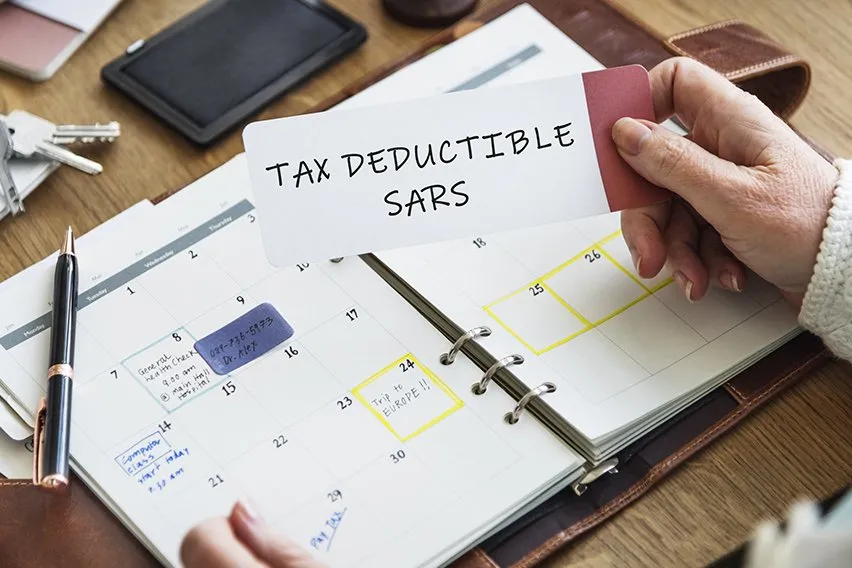How to Calculate PAYE Tax: Income Tax Calculator

When you pay your employees you’re going to include certain things on their payslips. For example, their hourly rate or basic salary, the number of hours worked and whether or not they worked overtime. But there are also certain deductions that you’re going to include.
These deductions can range from things like health insurance to pension contributions. But you’re also required to deduct certain taxes from their pay. One of these is known as PAYE, or Pay as You Earn, tax. And there are different rate bands and income tax reliefs for your employees.
Here is everything that you need to know about PAYE tax.
Here’s What We’ll Cover:
How to Calculate PAYE Tax: Income Tax Calculator
When and How Should It Get Paid?
What Is PAYE Tax?
This is the rate of tax that you’re required to deduct from an employee’s pay based on their remuneration period. The process of deducting this tax commonly gets referred to as PAYE and as an employer, there are a few things that you need to know.
According to South African law, you must register your business with the South African Revenue Service (SARS). You’re required to do this within 21 business days of registering as an employer unless you don’t have any employees who are liable for normal tax.
If you haven’t applied for registration of payroll taxes, just go to the eFiling website and register for PAYE. Keep in mind that you’re going to need to complete the EMP101e Payroll – Application for Registration taxes form.

It’s worth noting that if you are registered with SARS for PAYE, you also need to register for Unemployment Insurance Fund (UIF) contributions. This can also be the case if your business is registered for Skills Development Levy (SDL) purposes.
But the good news is that you’re able to register for all the tax types you need in one application using the client information system.
Once you’re all registered, you will need to pay any deducted or withheld amounts to SARS every month. And you do this by completing and submitting the Monthly Employer Declaration, or EMP201. This is basically a payment return where you declare the total payment, including any of the above-mentioned taxes.
When and How Should It Get Paid?
You’re required to pay SARS no later than seven days after the period in which you deducted the amounts. If the final day for payment ends up falling on a weekend or a public holiday, then payment needs to get made on the last business day.
There are a few different payment methods that are available for you to use. They include:
- Electronic payments (EFT)
- eFiling payments
As well, if you want to make your payments at the bank, you can do this at any Capitec, FNB, ASBA, Standard Bank or Nedbank branch. It’s important to know that SARS won’t accept manual forms of payment anymore. So if you send a cheque, for example, it will get returned.
You also need to submit Employee’s Tax declarations if you exceed R10 million in Employees tax in a 12-month period. And you need to make these payments electronically.
Calculating PAYE Tax
It doesn’t matter if you pay your employees on a weekly or fortnightly basis, you’re always going to pay SARS at the end of each month. The monthly payment amounts can change depending on how much an employee earns. And there are a few different ways that you can do this.
This first is with the periodic tax basis method. In this case, you calculate tax based on each employee’s payslip using monthly tax tables.
The second is the averaging and annual equivalent method. If you use this method, you will take into account the total income of your employees based on the entire tax year to date (YTD). You would then use the annual equivalent to help calculate the tax.
It’s worth noting that SimplePay doesn’t support the periodic tax method. However, they do support the averaging and equivalent method since it often provides a more accurate calculation. And this can especially be the case if your employees have a fluctuating income.

Let’s take a look at an example.
Using the annual equivalent calculation, you’re going to need to work out the annual equivalent of how the tax gets calculated. You do this by annualising employees YTD income and then de-annualise it to get the tax amount. Essentially, this is the total income your employees would earn for their YTD period if their average monthly income was multiplied by 12.
So, let’s say that you have one employee who is earning R15 000 for May and June. But, they also earn R20 000 in August, so their YTD annual income would be R50 000.
You would then calculate their annual equivalent like this:
Annual Equivalent = 50 000 / 3 x 12 = 200 000
Now, it’s important to recognize that there are two distinct types of income: irregular income and regular income. Irregular income would be something like a signing bonus. Regular income is what gets paid to your employees regularly, like salary or commission.
Since you know what an employee’s annual equivalent is and if they have regular or irregular income (or both), you can now use it to help calculate PAYE. Just make sure that you calculate tax based on appropriate tax tables.
You can find the most up-to-date tax table information on the SARS website. It will include any additional terms and even exemption limits.
Key Takeaways
PAYE is the amount of tax that you must deduct from employees’ payslips based on their remuneration period. You’re required to do this every month, and you have up to seven business days from the time the month ends to submit payment to SARS.
To calculate an employee’s PAYE using the annual equivalent calculation, follow these steps:
- Find their YTD income
- Determine their annual equivalent
- Calculate tax as per tax tables
- Determine PAYE that’s payable on their income
Keep in mind that there are going to be various tax thresholds depending on how much an employee earns. So if an employee falls under the threshold where they don’t need to pay tax, they would be entitled to a full refund when they submit their tax return. As an employee’s income increases, you will need to calculate additional payroll tax at a marginal rate.
But you’re still required to make monthly payments to SARS based on taxable income and tax rates. Plus, to help make things easier, SARS offers a PAYE tax calculator and a repayment calculator that you can use.
Did you enjoy reading this guide? Head over to our resource hub for more content!
RELATED ARTICLES

 What is Proof of Payment and How Do I Get Mine?
What is Proof of Payment and How Do I Get Mine? 3 Best Accounting Tools for Small Business
3 Best Accounting Tools for Small Business Tax-Deductible Expenses For Business: The Complete Guide
Tax-Deductible Expenses For Business: The Complete Guide What Is Provisional Tax & How to Pay? South Africa Tax Guide
What Is Provisional Tax & How to Pay? South Africa Tax Guide Tax Brackets in South Africa: A Taxpayer Guide
Tax Brackets in South Africa: A Taxpayer Guide